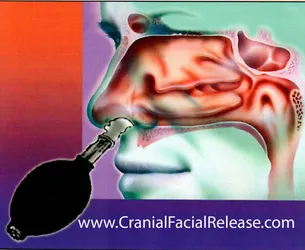
WHAT IS CRANIAL FACIAL RELEASE?
CRANIAL FACIAL RELEASE (CFR) IS AN ADVANCED ENDO-NASAL CRANIAL TECHNIQUE That has been used quite successfully in the relief of various neurological and structural disorders.
TO UNDERSTAND HOW CFR WORKS
It is important to realize that the skull is NOT one solid bone. It is made up of 22 individual bones that actually move every time you breathe – or at least they are supposed to.
THE OBJECTIVE OF CFR TECHNIQUE
Is to mobilize the bones in the face and cranium and to open up the breathing passageways with the purpose of mobilizing the cranial bones and facilitating normal cranial function
HOW THIS TECHNIQUE IS PERFORMED
CFR technique is performed by inserting tiny balloons in the nose (the nasopharynx) then quickly inflating them to mobilize the bones of the face and cranium. It feels very similar to the sensation experienced when jumping into a swimming pool and having water shoot up your nose. The entire procedure takes about 2 to 3 seconds, and consists of a series of 4-6 treatment over a 7-10 day period.
Conditions that respond favorably to CFR Treatments:
| Breathing Disorders | Learning Disorders |
| Sinus Conditions | Attention Deficit Disorder |
| Snoring | Parkinson’s Tremors |
| Sleep Apnea | Emotional Disorders |
| Migraine Headaches | Hearing Impairments |
| Head Trauma | Vision, Stigmatism |
| Post Concussive Syndrome | Glaucoma |
| Chronic Fatigue Syndrome | Anxiety |
| Trigeminal Neuralgia | Autism |
| Facial Paralysis | Depression |
| Bell's Palsy | Neurosis |
| Tinnitus | Epilepsy |
| Vertigo | Down Syndrome |
| Strokes | Cerebral Palsy |
| Insomnia | Multiple Sclerosis |
| TMJ Disorders | Muscular Dystrophy |
| Neurological Disorders |
Most people who come in for CFR treatment are of the last resort patients who have tried everything else first.
CFR often succeeds where other forms of conventional treatment have failed.
Disclaimer:
“It is important to note that CFR is not directed at the treatment of any one specific disease or disorder. It’s primary objective is to mobilize the cranial fixations, open the breathing passageways, facilitate cerebral spinal fluid flow, increase vascular flow to and venous drainage from the cranium, and optimize brain function. This is often times improves symptoms related to various structural and neurological disorders.”



